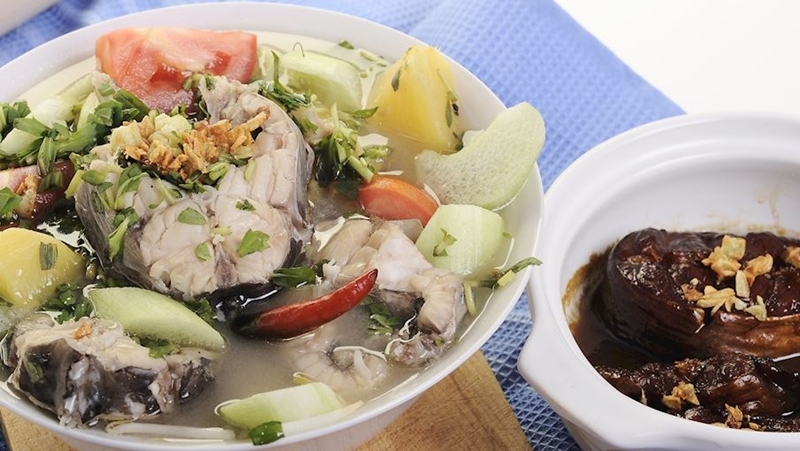 |
| Vietnamese sweet and sour soup, known locally as canh chua cá, is among Top 84 Southeast Asian seafood dishes |
The term canh chua cá encompasses various fish-based Vietnamese soups that are characterised by their combination of sweet, spicy, and sour tastes. The soups are usually made with a tamarind-based broth and typically include chunks of pineapple, tomatoes, okra, bean sprouts, or other vegetables, the website wrote.
Most varieties are prepared using catfish, although some versions include carp, snakehead fish, eels, or salmon. These soups are usually topped with cilantro before being served with rice on the side, according to food website TasteAtlas.
The 17 other local dishes to make the list include tomato and crab noodle soup, known in the nation as bún riêu; sun-dried squid, known locally as mực một nắng; sweet and sour tamarind soup, also called canh chua; caramelized fish in clay pot, cá kho tộ; crab meat and glass noodle stir-fry, miến xào cua; clam rice, cơm hến; turmeric fish with dill and noodles, chả cá lã vọng; and rice vermicelli with jellyfish and fish, bún cá sứa.
Topping the list is Pempek, a traditional Indonesian fish cake made with ground fish meat and tapioca.
Rounding off the list of TasteAtlas’s Top 84 Southeast Asian seafood dishes were many representatives from around the region, including ikan bakar of Indonesia, cereal prawns and chilli crab of Singapore, daing na bangus of the Philippines, and pla thot of Thailand.
TasteAtlas is an encyclopedia of flavours, a world atlas showcasing traditional dishes, local ingredients, and authentic restaurants. The website has cataloged over 10,000 foods and drinks from across the world, with dozens of thousands yet to be researched and mapped.
Festival tourism attracts large number of visitors
The tourism industry is gradually painting an image of a colourful Vietnam with four vibrant festival seasons, as various culture weeks and months and festivals organised year round across the country have drawn a large number of both domestic and foreign tourists.
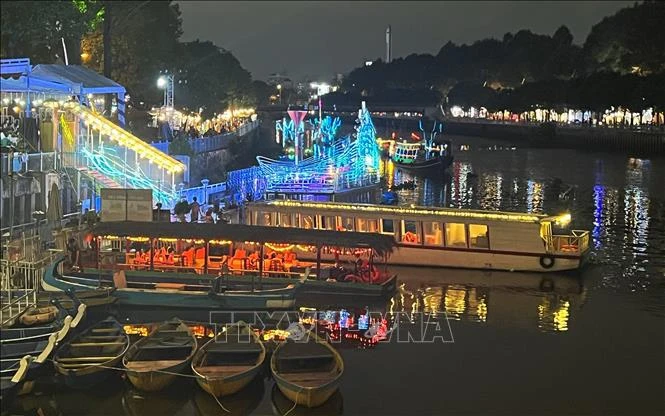 |
| 2024 Ho Chi Minh City River Festival (Photo: VNA) |
At the closing night of the 2024 Ho Chi Minh City River Festival, the sky in the southern metropolis was lit up by over 1,000 drones which created a spectacular display that drew thousands of spectators to the banks of the Saigon river.
Observing the performance from the rooftop of a restaurant in Thu Duc City’s Thao Dien area, Jonny Buckley, 33, from England, expressed his surprise, saying that the festival is very fascinating and Vietnam could expand its scale, making it even more attractive and renowned.
Before the festival, the city organised a wide range of events such as the Ho Chi Minh City Ao Dai Festival, the Ho Chi Minh City Tourism Day, the Ho Chi Minh City International Film Festival, the Vietnamese “Banh mi” Festival, and the upcoming HCMC International Music Festival.
Chairman of the municipal People's Committee Phan Van Mai recently said that the city will organise a series of events lasting from 1 to 2 weeks every month, transforming it into a city of festivals.
Domestic and international tourists have also flocked to central Da Nang city to enjoy breathtaking performances at the Da Nang International Fireworks Festival (DIFF), which kicked off on June 8.
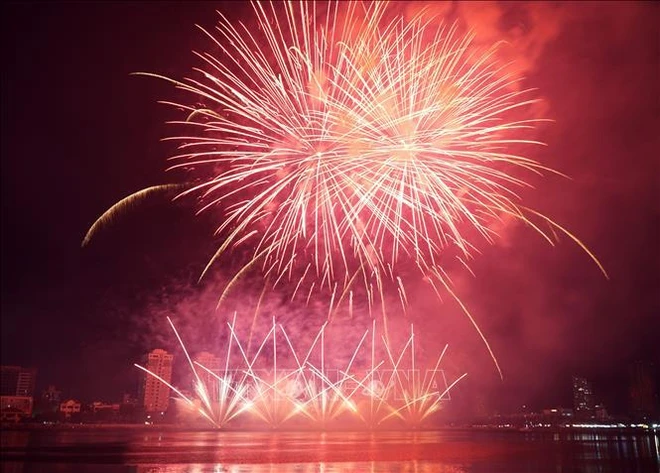 |
| Firework display at Da Nang International Fireworks Festival (Photo: VNA) |
The annual event has helped Da Nang build the ‘Fireworks Festival City’ brand and promote itself as a top destination in central Vietnam and Asia. Each festival attracts more than 1 million tourists, creating millions of US dollars in revenue for the city’s tourism industry, according to organisers.
In addition to the DIFF, Da Nang hosts 20 - 30 festivals each year, creating a lively and vibrant atmosphere of an energetic destination.
With its rich cultural heritage and history, the central province of Thua Thien-Hue is also striving to become a festival city by implementing the four-season festival initiative with a series of festive activities throughout the year.
Tourists can easily explore a plethora of unique traditional cultural features of Vietnam through a wide range of festivals across the country in all months of the year.
According to the latest report from the Department of Tourism of HCM City, the consecutive festivals and events organised since early this year have attracted a large number of domestic and international tourists, contributing to stimulating domestic tourism demand.
As of June this year, HCM City welcomed nearly 2.7 million international travelers and over 17.1 million domestic tourists, up 38% and 4.4% year-on-year, respectively, raking in 92.6 trillion VND (over 3.6 billion USD).
Statistics from restaurants and hotels in Ho Chi Minh City downtown also show that their revenues during festivals increase sharply compared to those on normal days.
Meanwhile, according to a survey by Booking.com, one of the largest travel e-commerce sites in the world, Da Nang retains the leading position and the most searched domestic destination status this summer. One of the reasons pointed out is thanks to the DIFF 2024 and its festive environment.
Forum discusses ways to tap potential for Vietnam-Japan tourism links
A forum to explore potential for Vietnam - Japan tourism cooperation 2024 was recently held in Tokyo by Fuji Travel company, with the sponsorship of the Vietnam Business Association in Japan and national flag carrier Vietnam Airlines, reported VOV.
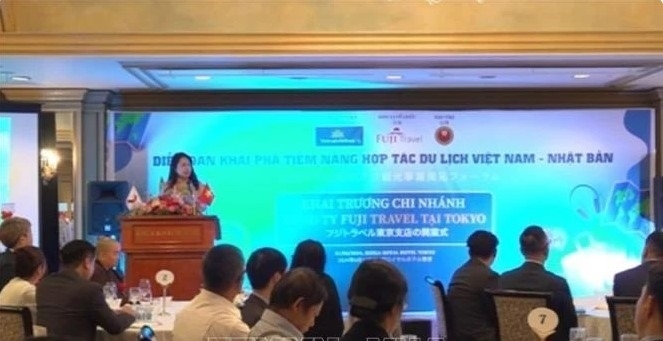 |
| Vu Nhat Ha, Vietnamese Embassy representative in Japan speaks at the event |
The event featured the participation of many experts, managers, and business representatives in the tourism sector from both countries.
As part of his address, Vu Nhat Ha, in charge of the investment department of the Vietnamese Embassy in Japan, highly appreciated the initiative to organise the forum, considering it to be an opportunity for businesses, managers, and partners in the tourism sector of the two countries to meet, exchange, and seek new co-operation opportunities.
Tong Thi Kim Giao, chairwoman of the Vietnam Business Association in Japan (VJBA), said that the tourism industry is not only a bridge connecting cultures, but also serves as a strong driving force to promote sustainable development and international and people-to-people exchanges.
Therefore, the Vietnamese business community based in Japan in general, as well as VJBA member businesses operating in the field of tourism in particular, always strives to find new directions in which to bring value in tourism co-operation between the two nations.
In his speech, Okamoto Hironobu, tourism ambassador of Yachiyo city in Ibaraki Prefecture, put fourth specific suggestions that he believes businesses operating in the Vietnamese tourism industry should pay close attention if they wish to attract Japanese tourists.
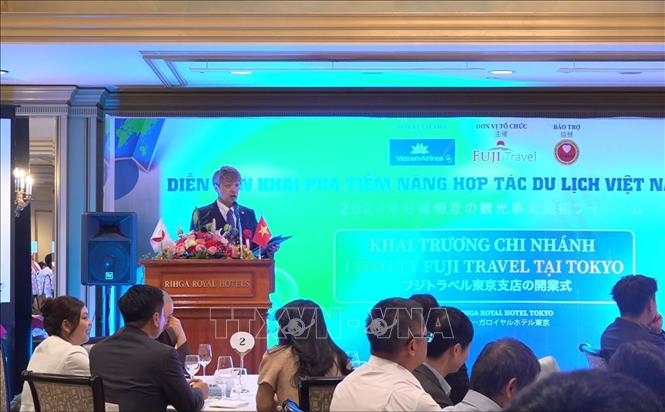 |
| Forum discusses ways to tap potential for Vietnam-Japan tourism links (Source: VNA) |
According to Hironobu, the nation has given him a positive impression due to its beautiful scenery, friendly people, and delicious food. He said that not only him, but also many of his friends and Japanese acquaintances had a good impression of the country.
Mentioning that the devaluation of the yen may cause Japanese people to reduce their travel abroad, Hironobu noted that because Vietnamese prices are not high when compared to other markets such as the United States and Europe, the number of Japanese tourists coming to Vietnam will not be affected.
He believes that if the Vietnamese tourism sector makes appropriate improvements, then the number of Japanese tourists coming to visit the country will increase in the time ahead.
Bui Thi Kim Phung, representative of the Forum Organizing Board and director of Fuji Travel Company, emphasized that the forum is a meaningful activity launched by member businesses of the Travel Club.
She believes that the delegates' good opinions and speeches at the forum will help to connect Vietnamese and Japanese tourism businesses more effectively.
At the forum, speakers presented additional opinions and reports affirming the richness and diversity of resources and the potential for joint tourism co-operation, thereby opening up greater opportunities to build ties and create unique and attractive tourism products that bring about common benefits to both countries./.